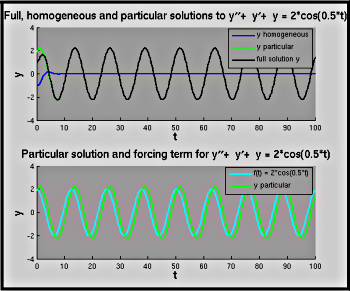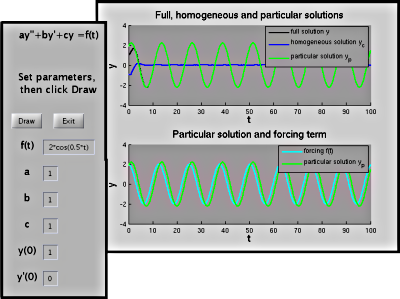Model Description
A radio, which we feel obligated to characterize as "an old-fashioned"
radio, receives a broadcast signal which can then be heard by sending it
to a speaker system to produce sound. There are, of course, many
signals being broadcast and which are received by the radio, and which
signal is used by the radio determined by the tuner in the radio,
which selects the carrier wave for the signal (or station) one is trying
to listen to. A very simple model of such a tuner is the RLC circuit
shown below.

Here the input voltage \(E(t)\) is the signal that is being received by
the tuner. \(R\), \(L\) and \(C\) are the resistance, inductance and
capacitance in the circuit. We can adjust the capacitance \(C\) to
select one frequency in the input—that is, by changing \(C\) we
can make the (long-term) behavior of the system mirror only one
of the frequencies in the input function \(E(t)\).
ODE Model
Let \(I\) be the current in the circuit and \(Q\) the charge on the capacitor. Then Kirchoff's second law (that the sum of the voltage drops in the circuit must equal the input voltage) and the elementary laws of electricity give \[ L\,\frac{dI}{dt} + R\,I + \frac1{C}\,Q = E(t), \] so that \[ L\,I'' + R\,I' + \frac{1}{C}\,I = E'(t) \] (see, for example, [1] or [2] for a fairly complete and fairly succinct derivation of this equation, respectively).
Following [1], we might take \(L = 1\)H (Henry, the unit of inductance) and \(R = 0.1\Omega\) (Ohms, the unit of resistance). Then, we may suppose that the input voltage is a combination of several carrier signals with different frequencies; for example, we might take \(E(t) = -\cos(t) - \frac45\cos(5t)\). For initial conditions, if there is initially no current, \(I(0) = 0\) and \(I'(0) = (E(0) - q_0/C)/L\). The question for the tuner is how to pick \(C\) so that \(I(t)\) looks like only one of the terms in the input \(E(t)\).
Of course, this requires that the current actually look like the input (or part of the input). The Method of Undetermined Coefficients argues that this is the case, and in these demonstrations we consider that correspondence. To do this initially it may be instructive to consider a further simplification of the model, in which we take a single input function, \(E(t) = -\cos(\omega t)\), and consider what the resulting current \(I(t)\) looks like. Because we know that this will be composed of homogeneous and particular solutions, we look at both of these. And because we are initially interested in considering how the Method of Undetermined Coefficients works, we may consider other input functions than oscillatory ones. We will return to the question of tuning the circuit to one input frequency in a subsequent demonstration.
Matlab Demos
A collection of Matlab demos for this:
- MUC_Simple.m:
A demonstration that shows the full, homogeneous and particular
solutions to the linear constant-coefficient differential equation
\(a y'' + b y' + c y = f(t)\), where \(a\), \(b\), \(c\), the
initial conditions and forcing function \(f(t)\) may be specified in
the configuration. Another configuration variable allows the
inclusion of a pause between graphs or not. If a forcing function
is not recognized, this will likely throw a warning and terminate
clumsily.
[show
figure]

- MUC_GUI.m:
A similar demonstration which provides a GUI interface to set the
values of \(a\), \(b\), \(c\), \(y(0)\), \(y'(0)\) and the forcing
function \(f(t)\). If a forcing function is not recognized, this
will likely throw a warning and terminate clumsily.
[show
figure]

Looking at the Model
Some questions that may be worth considering:
- Why do the particular and full solutions end up looking like the same function as time increases?
- Why do the particular solution and forcing function look similar?
